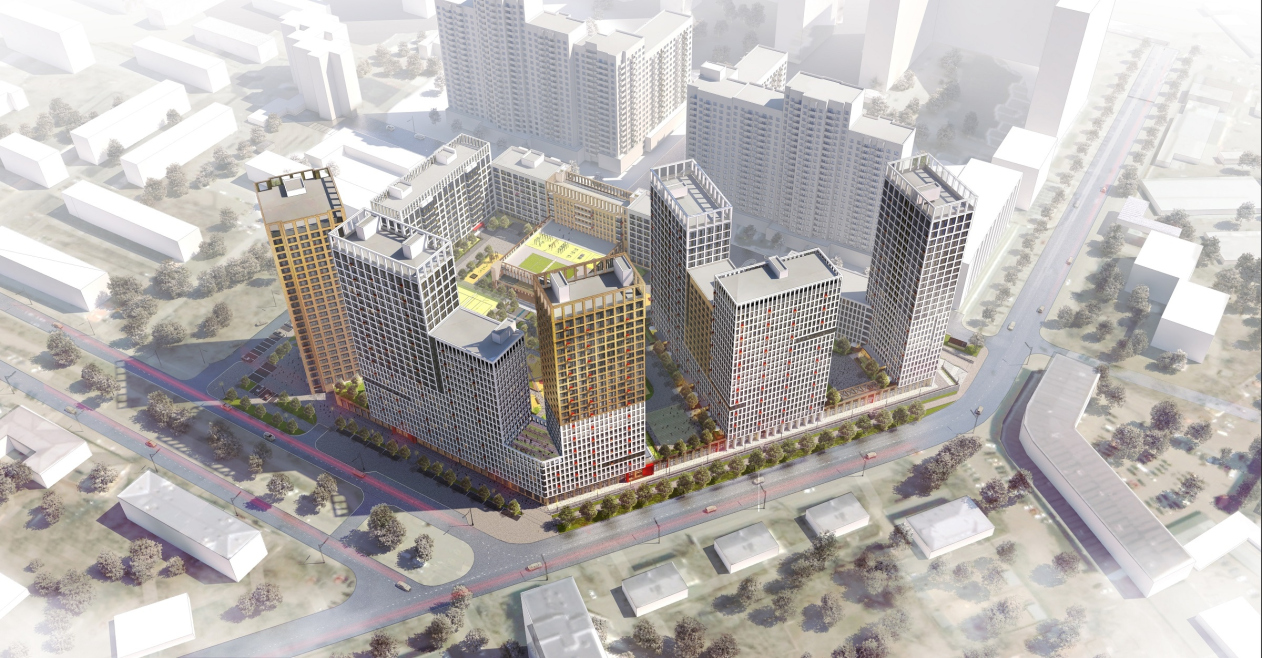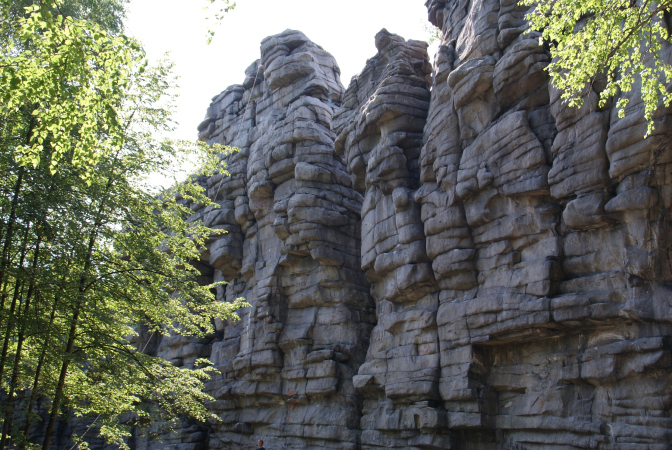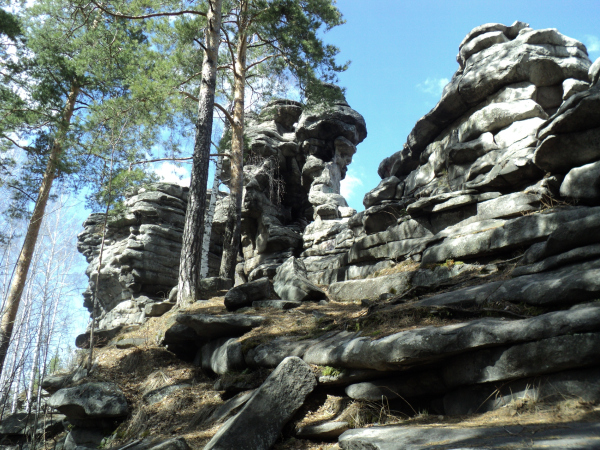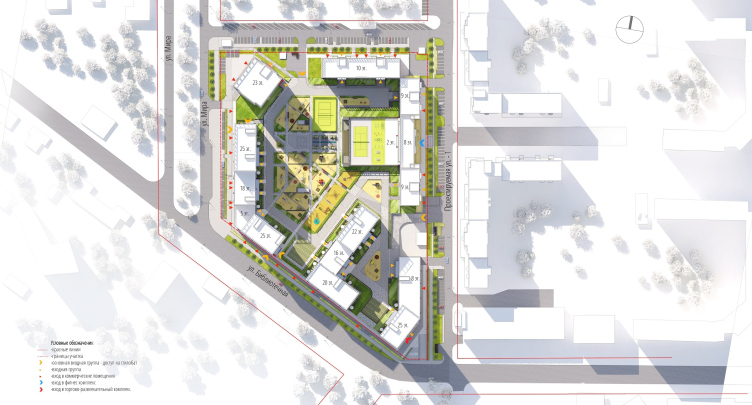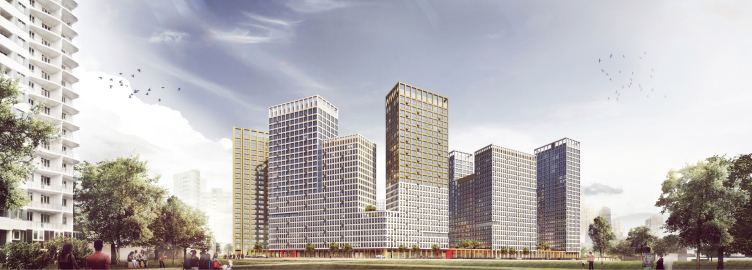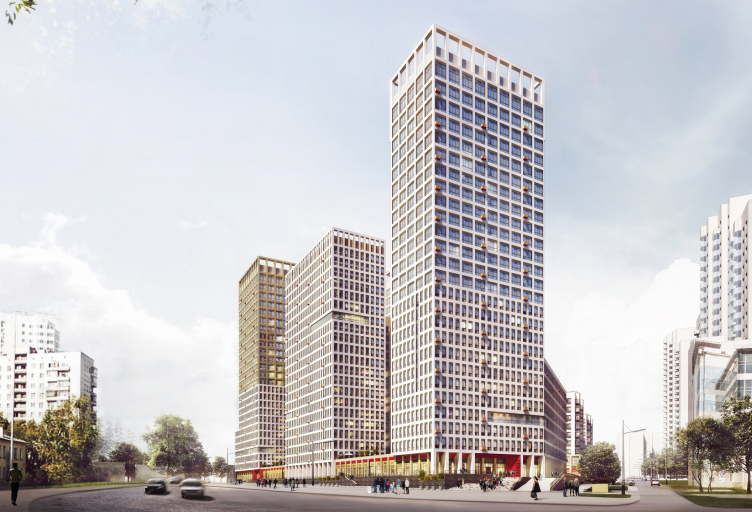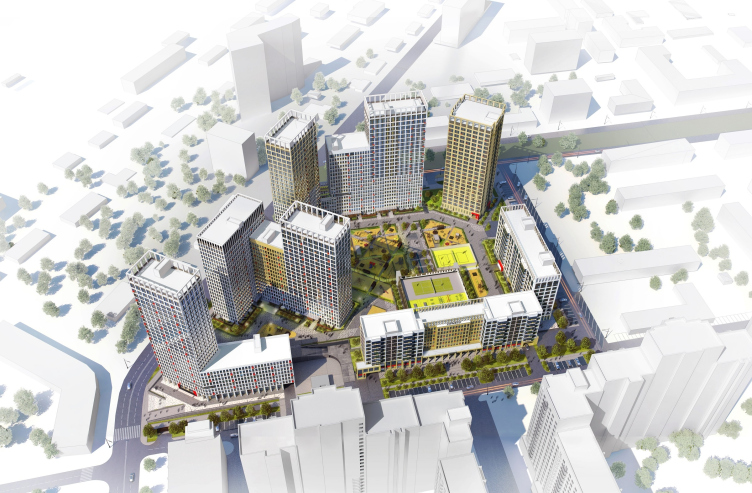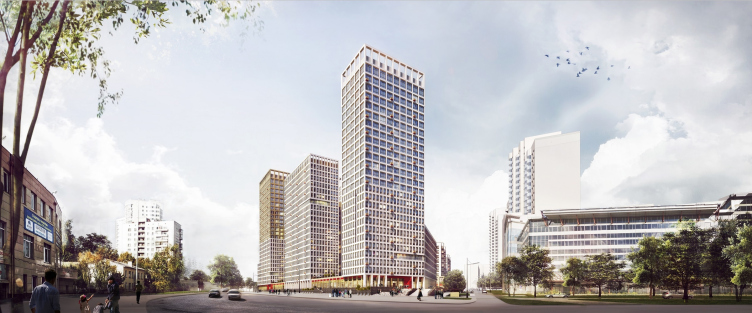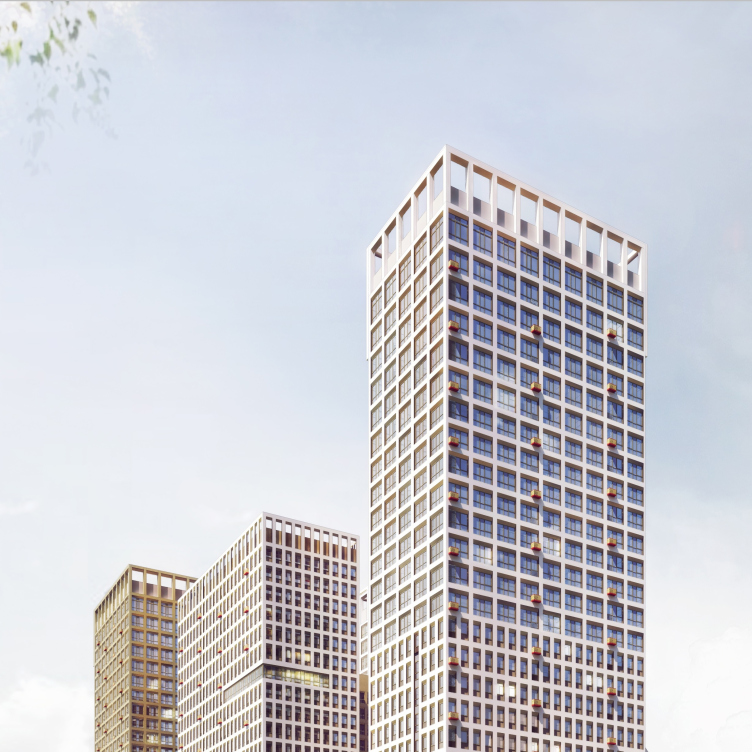The freshly-built “Universitetsky” micro-district, to which this multifunctional complex belongs, is situated on the outside belt of “Vtuzgorodok” residential area lying between the historical part of Ekaterinburg and its suburbs. It contains the campus of the Ural Federal University, institutes of the Ural division of the Academy of Sciences, and other educational and research institutions. Not far away from this micro-district, there is the “Shartash” railway station and a road junction with an exit to the relief road of the Siberian Highway, residential buildings of different height and year of construction, and a number of industrial parks.
The company “Pervostroitel” began to develop this large city block, constrained by the Komsomolskaya, Pedagogicheskaya, Bibliotechnaya, and Mira streets, in 2005 – since then, this place got a few multistory housing projects of a more or less typical appearance, as well as the accompanying infrastructure. A.Len got to work with the last undeveloped land site shaped like a triangle with a cutaway. With a share of healthy snobbery, one can assume that when the complex is finished, the contrast “provincial vs metropolitan” will be quite prominent. Still, though, it would be more appropriate to speak about the contrast between the typical and the designer architecture, because the suburbs of Saint Petersburg are just as full of faceless construction deaf to the context.
The “Universitetsky” multifunctional complex looks slightly different than its neighbors, which shows through in one of the early versions of its name: while the already-built housing complexes are named “Copernicus”, “Mendeleev” and “Lomonosov”, our hero was originally named “Prospect Mira Compound”. The very “compound” term is rarely used in Russia because it reflects a rather large chunk of reality. Anyway, according to Cambridge Dictionary, a compound is a substance that is a combination of two or more elements, or an area of land with a group of buildings surrounded by a fence or wall.
The composition of the complex is also arranged in accordance with its original name: a few buildings ranging from 5 to 23 stories high are placed on the perimeter of the land site, while on the central podium, a residents-only space is formed. Considering the fact that “Universitetsky” will also include a shopping mall and a fitness center, sports fields, and playgrounds, one can safely call it a city within a city.
A.Len is one of the few Russian architectural companies that is not alien to the ideas of bionic architecture. In this project, the architects were inspired by the Ural megaliths, and using their image helped the architects to achieve a dramatic silhouette and visually “relieve” rather large planes of the façades.
“Universitetsky” multifunctional compound. Birds-eye view
Copyright: © A.Len
Along the Mira and the Bibliotechnaya streets – where the complex faces the railway station – stand the tallest buildings with “spikes” of 25 stories and “valleys” of only five. These spikes and valleys create extra “air”, letting one’s gaze wander around and explore the “negative space”. Two towers at the crossroads, almost menhirs, are turned 45 degrees, which yields a more rounded, and, consequently, a more organic-looking outline, as well as forms two small triangular plazas, one of which, because of the height drop, got an amphitheater staircase accentuating the entrance to the shopping mall.
“Universitetsky” multifunctional complex. Birds-eye view
Copyright: © A.Len
“Universitetsky” multifunctional complex. Perspective image
Copyright: © A.Len
“Universitetsky” multifunctional complex. Fragment
Copyright: © A.Len
The buildings of a smaller height are placed closer to the high-rise cluster, and this is also the place where the entrance to the fitness center is situated, which is continued on the territory of the residents-only yard with a two-story building that has a tennis court on its roof.
Yet another high-rise slab enters the yard space, twisting it like a spiral and dividing it in two: the smaller and the larger one. If we are to continue the parallel with the megalithic structures, there is a structure that looks a little bit like cromlech that missed a few rocks on its inner circle. In such interpretation, the yard gets a special role – namely, that of a sacred open-air space, where different streams of people come together. The architects make the yard vehicle-free, making various spots for people: playgrounds and sports fields, quiet and “active”, connecting them all with a network of pedestrian streams.
There are four main entrances to the podium – one for each street. The entrance groups are mostly situated in the yard of the complex; on the outside perimeter, the first floor is occupied by retail. There are two entrances to the double-level underground parking garage: one next to the fitness center and one in the north part of the complex; from here, should such need arise, emergency vehicles can drive up on the podium.
“Universitetsky” multifunctional complex. Fragment
Copyright: © A.Len
Playing with heights and masses creates a basis for turning the economic performance figures into architecture, and the project is crowned with the plastique of the façades. In “Universitetsky”, A.Len uses two modular grids of windows, breaking up the façades into large blocks. A denser grid with a 1650 mm step creates an impression of a sturdy base, while the sparser one – 3300 mm – makes the complex look slenderer, setting the upward motion, the same purpose served by the decorative parapets on the roof.
“Universitetsky” multifunctional complex. Birds-eye view
Copyright: © A.Len
“Universitetsky” multifunctional complex. Perspective image
Copyright: © A.Len
The “land marking” becomes still more prominent at the expense of a contrastive golden color. It must be said, by the way, that color is an important part of the company’s creative approach. Inclusions of bright red add extra beauty to the rhythmic pattern. In a few places, the façades are “slit” by glass bands that look like parts of the rocks honed by the wind or water.
“Universitetsky” multifunctional complex. Fragment
Copyright: © A.Len
The end result is quite impressive: a large-scale complex with more than a hundred thousand square meters of useful floor space is organized in such a way that it is a really interesting thing to look at. In 2018, the project got a golden diploma of “ARKHITEKTON” festival.
“Universitetsky” multifunctional complex. Development drawings
Copyright: © A.Len

